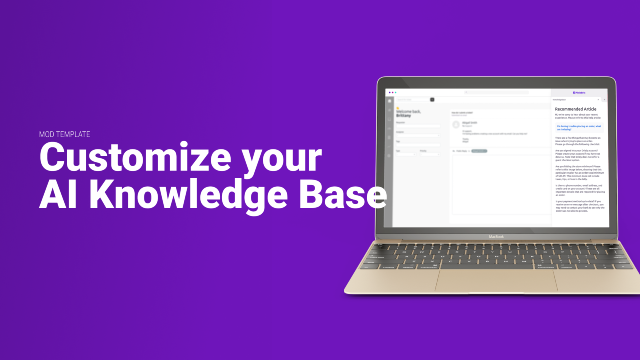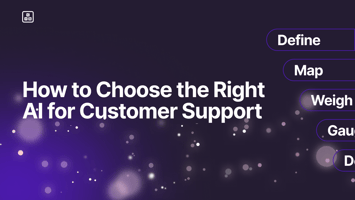The old email inbox can get a bit overwhelming. Between essential project updates from your team,...
How To Build a Knowledge Base (And Why It’s Essential for Customer Success)
They say knowledge is power, and it’s absolutely true for the knowledge management software. Think of a knowledge base platform a bit like a library. How much easier is it to pull the right book from a shelf at the library than from a pile at a used bookstore? But while the library is great for all sorts of knowledge, a knowledge base does one of two things. Either it helps customers fix problems they encounter when using what your company sells or it helps a team do their work more efficiently.
Here’s why.
What is a knowledge base?
At its simplest, an internal knowledge base is an online collection of guides, tutorials, and other resources. It can be customer-facing, meaning that the resources in it are intended to help customers work through any issues they may have with your product or service. It can also be internal when it gives employees the resources they need to do their job more effectively. Customer success teams often use both types of knowledge bases. A customer-facing knowledge base will give them quick access to documentation they can provide to customers while an internal knowledge base will help them get onboarded quickly when they start — and have all the information they need to do their job at their fingertips.
Most companies use purpose-built tools to build a knowledge base, such as Intercom, Zendesk, or HubSpot. These tools often have a number of other useful features for customer success teams, like built-in chatbots and support ticket management.
Why your customer success team needs a knowledge base.

Think of the metrics you use to measure your customer success team’s performance, whether that’s first contact resolution rate, customer satisfaction score, or overall customer health scores. Having a knowledge base — of either kind — can directly improve all of these metrics.
A customer-facing knowledge base can reduce the overall number of incoming support requests, freeing up more time for your customer success team to help customers with issues that actually need their support. Having a database of troubleshooting guides and product information on hand also means they can quickly match up a customer with the resources they need to solve a problem.
An internal knowledge base can have just as much of an impact on your team’s performance since it serves essentially the same purpose for them as a customer-facing knowledge base does for customers. When you build an internal knowledge base, you’re creating a database full of answers to common questions, guides for getting things done efficiently, and ramp-up advice for new hires. That means new customer success agents can contribute to the team faster, and your managers don’t have to repeatedly answer the same questions.
So now that you know why you need a knowledge base, here’s how you build one.
How to build a knowledge base
Whether you’re building a customer-facing knowledge base or an internal one, the steps you need to follow will essentially be the same. This assumes that you’re using a dedicated knowledge-base tool or the best knowledge base software rather than building a website from scratch. PixieBrix is the perfect knowledge base builder.
Step 1: Identify the user’s needs
“User” means anyone who’ll be going to your knowledge base looking for resources, whether that’s a customer for a customer-facing knowledge base or a team member for an internal one. What are some common questions that keep coming up? Does your product or service need in-depth guides for even the toughest issues or does your organization provide guided customer service in most cases? What are some problems your teams keep running into while they work?
Step 2: Start working on the knowledge base’s structure
A knowledge base needs to be more than a long list of articles your readers will pick out from. You need some kind of overarching structure that’s intuitive and easy to navigate. Otherwise, your knowledge base will create more questions than it answers. Here’s an example of a structure you might use for a customer-facing knowledge base:
- Getting started: For the most basic product information.
- Setup guides: How to set up a product or service for specific needs.
- Troubleshooting information: How customers can fix specific problems.
- Frequently asked questions: For those issues that keep coming up.
Here’s an example of how you’d structure an internal knowledge base:
- Onboarding materials: For new hires to get started more quickly.
- Software guides: A collection of guides and problem-solving resources for the software your team uses frequently.
- Internal processes: Documentation that can help team members know how to get certain things done, from asking for vacation time to submitting work for approval.
- Frequently asked questions: A resource for questions that come up frequently.
Don’t treat the structure you come up with at this stage as final! Your knowledge base should evolve as the organization and the team do.
Step 3: Create the content for your knowledge base
Now that you have a structure in place, you’ll have to actually fill it out with those helpful resources, guides, and troubleshooting steps. Make lists of absolutely essential content for each category, content that’s more of a nice-to-have, and content that you want to avoid adding in — either because it’s not a good fit or it would take too much time to create.
Using a database tool like Airtable or a spreadsheet tool is a great way to track what you need to create and what’s been done. Once you’ve made the plan, start writing!
Step 4: Help your knowledge base to grow
A knowledge base is a living database that needs the flexibility to evolve over time. That’s why it’s a good idea to use purpose-built knowledge base software; it makes it remarkably easy to update everything.
Keep your ears open for new requests, concerns, and other types of feedback. For a customer-facing knowledge base, you’ll want to regularly check in with the customer success team to know which questions come up regularly — with no answers from your knowledge base. You’ll also want to know which resources aren’t performing as well as they should.
For an internal knowledge base, you can ask the team for feedback; they’ll usually be happy to give it!
Knowledge is power
A knowledge base can help your team’s overall metrics, but it can also cut down on Slack notifications and accelerate the onboarding process. Building one can be a huge project, but the payoff is more than worth the effort. Your customer success team will thank you!


